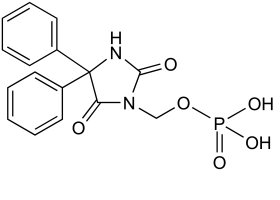Cerebyx
Fosphenytoin (Cerebyx®, Parke-Davis; Prodilantin®, Pfizer Holding France) is a water-soluble phenytoin prodrug used only in hospitals for the treatment of epileptic seizures. more...
On 18 November 2004, Sicor Pharms received a tentative approval letter from the United States Food and Drug Administration for a generic version of fosphenytoin.
Uses
Approved
Fosphenytoin is approved in the United States for the short term (five days or less) treatment of epilepsy when more widely used means of phenytoin administration are not possible or are ill-advised, such as endotracheal intubation, status epilepticus or some other type of repeated seizures; vomiting, and/or the patient is unalert or not awake or both.
Unapproved/Off-label/Investigational
In April of 2003, Applebaum and colleagues at the Ben Gurion University of the Negev in Beersheva reported that even though anticonvulsants are often very effective in mania, and acute mania requires rapid treatment, fosphenytoin had no antimanic effect even 60 minutes after administration of doses used in status epilepticus.
Fosphenytoin was more successfully used to relieve pain refractory to opiates in a 37-year-old woman with neuroma, according to Dr. Gary J. McCleane of the Rampark Pain Center in Lurgan, Northern Ireland. She was given 1,500 phenytoin equivalent units of fosphenytoin over a 24 hour period, producing pain relief that last three to fourteen weeks after each infusion, allowing her to use less opiates.
Metabolism
One mmol (millimole) of phenytoin is produced for every mmol of fosphenytoin administered; the hydrolysis of fosphenytoin also yields phosphate and formaldehyde, the latter of which is subsequently metabolized to formate, which is in turn metabolized by a folate dependent mechanism.
Side effects
Side effects are similar to phenytoin, except that fosphenytoin causes less hypotension and more paresthesia. Fosphenytoin can cause hyperphosphatemia in end-stage renal failure patients.
Read more at Wikipedia.org



